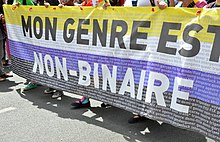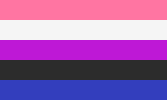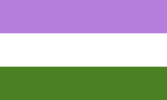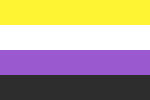Intergender
Non-binary people may identify as an intermediate or separate third gender, identify with more than one gender or no gender, or have a fluctuating gender identity. Gender identity is separate from sexual or romantic orientation: non-binary people have various sexual orientations.
Being non-binary is also not the same as being intersex. Most intersex people identify as either men or women, though some identify as only non-binary, some identify as non-binary and genderfluid, such as Hida Viloria, while others identify as non-binary men or non-binary women.
Non-binary people as a group vary in their gender expressions, and some may reject gender identity altogether. Some non-binary people receive gender-affirming care to reduce the mental distress caused by gender dysphoria, such as gender-affirming surgery or hormone replacement therapy.
Terms and Definitions
The term genderqueer first appeared in queer zines of the 1980s, preceding the more widely used "non-binary." It gained prominence in the 1990s through activists, like Riki Anne Wilchins. who used it in a 1995 essay and a 1997 autobiography to describe individuals deviating from traditional gender norms. By 2002, the term had further dissemination through the anthology Genderqueer: Voices Beyond the Sexual Binary. The rise of the internet and public identification by celebrities brought genderqueer into mainstream awareness during the 2010s.
Genderqueer serves as both an umbrella term for non-binary identities and an adjective describing those who challenge or diverge from conventional gender distinctions, regardless of how they personally identify. It encompasses a range of expressions that transcend the typical binary categories of "man" and "woman.".
Additionally, genderqueer is associated with gender ambiguity, and Androgynous (also androgyne) often used to describe a blend of socially defined masculine and feminine traits. However, not all genderqueer individuals identify as androgynous; some may identify with traditionally masculine or feminine traits or use alternative descriptors like "masculine woman" or "feminine man." The term "enby," derived from the initials "NB" for non-binary, is also commonly used. It’s important to note that being non-binary is distinct from being intersex, with most intersex individuals identifying as either male or female.
The term transgender often includes those who are genderqueer or non-binary, reflecting a broad spectrum of gender diversity. This inclusive usage dates back to at least 1992, with significant contributions from figures like Leslie Feinberg and Kate Bornstein, who emphasized the shared experiences of "gender outlaws." " Organizations like the Human Rights Campaign Foundation and Gender Spectrum use gender-expansive to denote a broader range of gender identities and expressions than those typically associated with the binary gender system.
Identities
Agender
Agender individuals, also known as genderless, gender-free, non-gendered, or ungendered, identify as having no gender or gender identity. This group represents a spectrum of identities that diverge from conventional gender norms.According to scholar Finn Enke, not all agender individuals may self-identify as transgender. While there is no universally accepted set of pronouns for agender people, singular they is commonly used, but it is not the default. Notably, "Agender" and "Neutrois" were among the custom gender options added to Facebook in February 2014 and to OkCupid since November 2014.
Multigender/polygender
These terms describe individuals who experience more than one gender identity, either simultaneously or alternately. This category includes identities such as demigender, bigender, pangender, and genderfluid. In contrast, those who experience a singular, unchanging gender are referred to as monogender or genderstatic.
Bigender
Bigender individuals possess two distinct gender identities which can manifest simultaneously or fluctuate between masculine and feminine expressions. This differs from genderfluid identities, which may not involve fixed gender states but rather a fluid range across the gender spectrum. The American Psychological Association recognizes bigender identity as part of the broader transgender category. Surveys and studies, including a 1999 San Francisco Department of Public Health survey and a 2016 Harris poll, have documented the prevalence of bigender identification, particularly within younger generations. Trigender people shift among male, female, and third gender.
Demigender
Individuals identifying as demigender feel a partial connection to one gender while also identifying with another gender or none at all (agender). Subcategories include demi-boy or demi-man, who partially identify as male, and demi-girl, who are partly female and partly non-binary. Demiflux people experience a stable non-binary identity with varying intensities of other gender identities.
Pangender
Pangender individuals identify with multiple or all genders, sometimes experiencing all these identities simultaneously.
Genderfluid
Genderfluid individuals do not adhere to a fixed gender identity; their gender expression may change over time, combining elements from various genders at different times. This identity can overlap with bigender, trigender, or pangender expressions.
Transfeminine or transmasculine
Transfeminine refers to individuals assigned male at birth but who predominantly identify or express themselves as feminine. Transmasculine refers to those assigned female at birth who predominantly identify or express themselves as masculine. These terms encompass both binary and non-binary identities.
Two-spirit
Originating from a 1990 Indigenous LGBT gathering in Winnipeg, the term Two-spirit refers to individuals within Indigenous North American communities who embody qualities or fulfill roles across traditional gender distinctions.
Xenogender
Xenogender encompasses a variety of gender identities that are defined using non-traditional concepts often drawn from natural, inanimate, or abstract sources, representing a departure from the typical human gender binary.
Other identities
This includes identities such as maverique, aporagender, ambigender, intergender, and genderflux, each presenting unique perspectives and experiences outside conventional gender norms.
History


Non-binary gender, often included within the concept of third gender, has historical roots that extend well before the modern term was established. For instance, the Public Universal Friend, who emerged in 1776, was a genderless evangelist who renounced their birth name and gendered pronouns, representing an early instance of non-binary gender expression in America.
In 1781, Jens Andersson from Norway, assigned female at birth but identifying as male, faced imprisonment and a trial after marrying a woman. When questioned, Andersson stated, "Hand troer at kunde henhøre til begge Deele" ("He believes he belongs to both parts"), indicating a recognition of his dual gender identity.
Judith Butler's Gender Trouble, published in 1990, challenged the fixed male/female binary and advocated for a broader understanding of gender as a spectrum, a view Butler has expanded upon since coming out as non-binary in 2019.
The term "genderqueer" surfaced in the mid-1990s, notably used by activist Riki Wilchins in the newsletter In Your Face in 1995, and later in their 1997 autobiography. Wilchins contributed significantly to the discourse, particularly with the 2002 anthology GenderQueer: Voices from beyond the Sexual Binary.
Jim Sinclair, an autism-rights activist and a founder of Autism Network International, publicly embraced a gender-neutral identity in 1997, declaring a physical and social neuter status in an introduction to the Intersex Society of North America.
In Japan, the expression "X-gender" (x-jendā) has been recognized since the late 1990s, describing a non-binary identity, with notable individuals like manga artists Yūki Kamatani and Yuu Watase identifying as such.
In 2012, the Intersex & Genderqueer Recognition Project began advocating for more inclusive gender options on official documents, a milestone realized when Elisa Rae Shupe became the first person in the U.S. to obtain official documents with a non-binary gender marker.
Alberta legislator Estefan Cortes-Vargas openly identified as non-binary during a 2015 legislative session, marking a significant moment in political recognition of non-binary identities.
Pronouns and titles

Many non-binary people use gender-neutral pronouns with the singular "they", "their" and "them" being used most commonly in English. Some non-binary individuals opt for neopronouns such as xe, ze, sie, co, and ey. Others may use traditional gender-specific pronouns like "he" or "she", switch between them, or prefer to use their name without pronouns. The title Mx. is also increasingly used as a gender-neutral honorific.
A significant 2015 study by the National Center for Transgender Equality surveyed nearly 28,000 transgender people in the United States, finding that 35% identified as non-binary or genderqueer. Among them, 84% used pronouns different from those associated with the gender on their birth certificates. The breakdown of preferred pronouns was 37% for "he/him," 37% for "she/her," and 29% for "they/them." Additionally, 20% did not request specific pronouns be used for them, and 4% used pronouns not listed in the survey.

In a 2023 Gender Census survey, 40,375 participants provided insights into how they describe their gender identity and their preferred references. The key identity labels reported were nonbinary, used by 63.1% of respondents (down 0.8% from the previous year), queer (54.8%, up 0.2%), trans (46.7%, up 8.5%), a category described simply as a person/human/[my name]/“I’m just me” (42.5%, newly included this year), and transgender (40.3%, up 6.4%). The survey also explored title preferences, with 40.1% preferring no title at all (up 1.5%), followed by Mx (18.7%, down 1.4%), Mr (11.5%, up 2.1%), non-gendered professional/academic titles (9.4%, up 1.0%), and Ms (5.5%, up 1.1%). Pronoun usage varied, with "they/them" being the most popular at 74.5% (down 1.2%), "he/him" at 42.5% (up 2.1%), "she/her" at 32.7% (no change), "it/its" at 19.4% (up 3.2%), and a preference for avoiding pronouns or using names as pronouns at 13.2% (up 2.1%). This data offers a comprehensive view of the diverse and evolving ways individuals within the non-binary community identify and prefer to be referred to.
Legal recognition
Many non-binary/genderqueer people use the gender they were given at birth to conduct everyday business, as many institutions and forms of identification—such as passports and driver's licenses—only accept, in the sense of recorded recognition, binary gender identities. But with the increasing acceptance of non-binary gender identities and the rise in wider societal recognition, this is slowly changing, as more governments and institutions recognize and allow non-binary identities.
Multiple countries legally recognize non-binary or third gender classifications. Some non-Western societies have long recognized transgender people as a third gender, though this may not (or may only recently) include formal legal recognition. In Western societies, Australia may have been the first country to legally recognize a classification of sex outside of "male" and "female" on legal documentation, with the recognition of Alex MacFarlane's intersex status in 2003. The wider legal recognition of non-binary people—following the recognition of intersex people in 2003—in Australian law followed between 2010 and 2014, with legal action taken against the New South Wales Government Registry of Births, Deaths and Marriages by transgender activist Norrie May-Welby to recognize Norrie's legal gender identity as "non-specific". India's Supreme Court formally recognized transgender and non-binary people as a distinct third gender in 2014, following legal action taken by transgender activist Laxmi Narayan Tripathi. In July 2021, Argentina incorporated non-binary gender in its national ID card, becoming the first country in South America to legally recognize non-binary gender on all official documentation; non-binary people in the country will have the option to renew their ID with the letter "X" under gender.
While the United States does not federally recognize a non-binary gender, in 2016 Oregon became the first state to recognize a non-binary gender identity. In 2017, California passed an act allowing citizens to identify as "non-binary" on official documents. As of 2019, eight states have passed acts that allow "non-binary" or "X" designations on certain identifying documents. One of the main arguments against the inclusion of a third gender identifier in the U.S. is that it would make law enforcement and surveillance harder, but countries that have officially recognized a third gender marker have not reported these issues. In the U.S. there are no explicit laws to protect non-binary people from discrimination, but under Title VII of the Civil Rights Act of 1964, it is illegal for an employer to require employees to conform to gender stereotypes, or to fire them merely for being transgender.
Discrimination
Various countries throughout history have criminalized transgender and non-binary gender identities.
In the U.S., 13% of respondents to the 2008 National Transgender Discrimination Survey chose "A gender not listed here". The "not listed here" respondents were 9 percentage points more likely to report forgoing healthcare due to fear of discrimination than the general sample (36% compared to 27%). 90 percent reported experiencing anti-trans bias at work, and 43 percent reported having attempted suicide.
The reported discrimination non-binary people face includes disregard, disbelief, condescending interactions, and disrespect. Non-binary people are also often viewed as partaking in a trend and thus deemed insincere or attention-seeking. As an accumulation, erasure is often a significant form of discrimination non-binary people face.
Misgendering, intentional or not, is also a problem that many face. In the case of intentional misgendering, transphobia is a driving force. Additionally, the use of they/them pronouns is lumped into the larger, controversial, subject of safe spaces and political correctness, causing pushback and intentional misgendering by some people.
Non-binary and transgender identifying people also face discrimination in sports participation. Non-binary identifying athletes have an immediate barrier as most sports competitions are divided into men's and women's categories.
Healthcare
Nonbinary people may report significantly less well-being and overall health than binary transgender people, though current research demonstrates conflicting perspectives on this topic. These health disparities may be exacerbated by minority stress by breaking gender and social norms.
Healthcare professionals are often uninformed about nonbinary people's specific health needs, sometimes requiring nonbinary patients to educate them. Some providers may believe that nonbinary people do not require transition-related treatment, while others may not understand the difference between their identity and the identities of binary transgender patients. Nonbinary patients report lower rates of respect from healthcare providers than binary transgender people.
Transgender health care
Some nonbinary people desire gender-affirming health care, including hormone replacement therapy or surgery. Others do not, and the ratio of those who desire care to those who do not is unclear. The factors that lead to this decision are complex and unique to each person.
Nonbinary patients seeking gender-affirming care typically begin treatment earlier than binary transgender patients.
Mental health care
Nonbinary people are likely to face more mental stress than binary transgender individuals.
Symbols and observances

Many flags have been used in non-binary and genderqueer communities to represent various identities. There are distinct non-binary and genderqueer pride flags. The genderqueer pride flag was designed in 2011 by Marilyn Roxie. Lavender represents androgyny or queerness, white represents agender identity, and green represents those whose identities which are defined outside the binary. The non-binary pride flag was created in 2014 by Kye Rowan. Yellow represents people whose gender exists outside the binary, purple represents those whose gender is a mixture of—or between—male and female, black represents people who have no gender, and white represents those who embrace many or all genders.
Genderfluid people, who fall under the genderqueer umbrella, also have their own flag. Pink represents femininity, white represents lack of gender, purple represents mixed gender or androgyny, black represents all other genders, and blue represents masculinity.
Agender people, who also sometimes identify as genderqueer, have their own flag. This flag uses black and white stripes to represent an absence of gender, and a green stripe to represent non-binary genders.
International Non-Binary People's Day is celebrated on July 14. Other observances with non-binary participation include International Transgender Day of Visibility, observed on March 31, and International Day Against Homophobia, Biphobia, and Transphobia, observed on May 17.
-
Transgender pride flag, in which white represents non-binary people
-
Agender pride flag
-
Bigender pride flag
-
Genderfluid pride flag
-
Genderqueer pride flag
-
Trigender pride flag
-
Non-binary gender symbol
-
Agender symbol
-
Genderfluid symbol
Population figures
Argentina
On July 20, 2021, President Alberto Fernández signed Decreto 476/2021, mandating that the National Registry of Persons (RENAPER) allow a third gender option on all national identity cards and passports, marked as "X". The measure also applies to non-citizen permanent residents who possess Argentine identity cards. The 2022 national census, carried out less than a year after the resolution was implemented, counted 8,293 (roughly 0.12%) of the country's population identifying with the "X / other" gender marker.
Brazil
A 2021 survey published in Scientific Reports concluded that 1.19% of Brazilian adults are non-binary, but the study did not ask whether they self-identified as non-binary. Because the authors considered most Brazilians unfamiliar with North American gender terminology, more open-ended questions about gender were asked.
Canada
In April 2022, Statistics Canada released findings from the 2021 census, making Canada the first country to ask a core question about gender identity, and found that 41,355 Canadians aged 15 and over identified as nonbinary.
A 2019 survey of the two-spirit and LGBTQ+ population in Hamilton, Ontario, called Mapping the Void: Two-Spirit and LGBTQ+ Experiences in Hamilton showed that 19% of the 906 respondents identified as non-binary.
A 2017 survey of Canadian LGBT+ people called LGBT+ Realities Survey found that 4% of the 1,897 respondents identified as non-binary transgender and 1% identified as non-binary outside of the transgender umbrella.
Switzerland
A 2021 survey found that 0.4% of adults in Switzerland describe themselves as non-binary. The survey of 2,690 Swiss residents was weighted to be reflective of the entire population.
United Kingdom
According to the 2021 United Kingdom census, 0.06% of the population in England and Wales identified as non-binary. The proportion was highest among people aged 16 to 24 years (0.26% or 17,000).
United States
According to a 2021 study by the Williams Institute, an estimated 1.2 million American adults aged between 18 and 60 identify as non-binary, making up 11% of the LGBTQ population in that age bracket.
A 2020 survey by The Trevor Project found that 26% of LGBTQ youth (ages 13–24) in the U.S. identify as non-binary.
According to The Report of the 2015 U.S. Transgender Survey, 35% of the nearly 28,000 transgender respondents to the anonymous online survey identified as non-binary.









